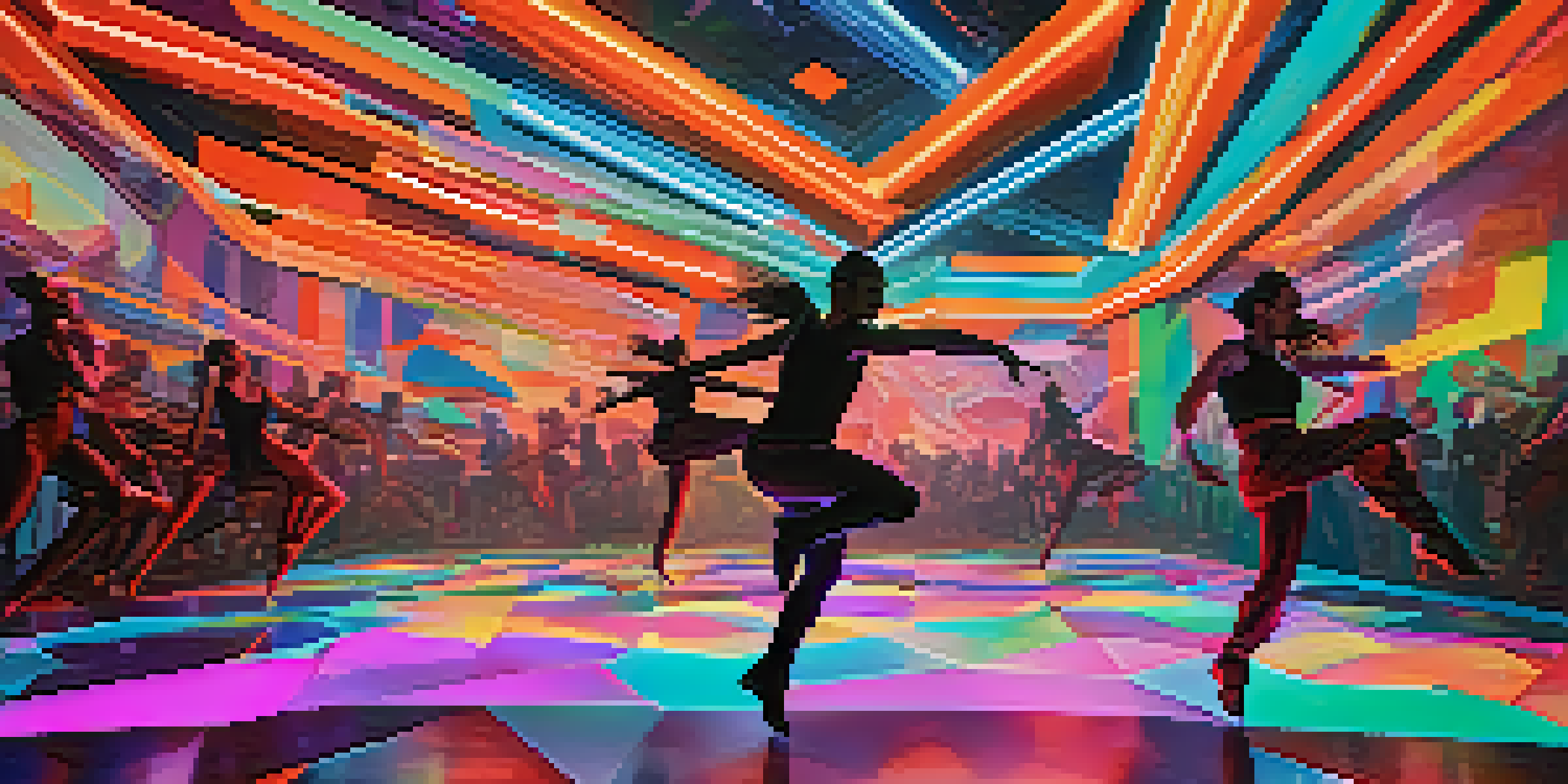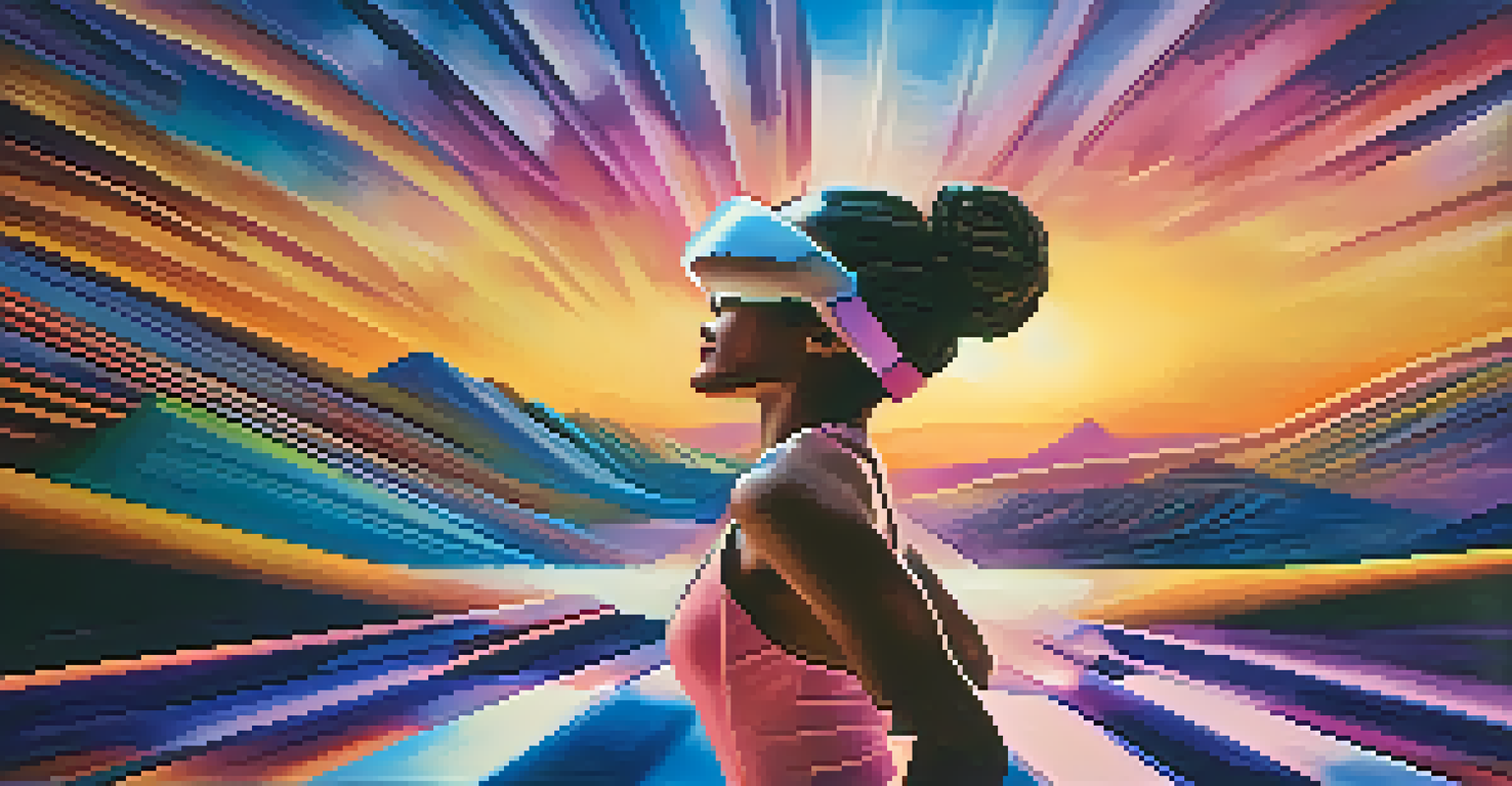Exploring Virtual Reality's Impact on Contemporary Dance Forms

The Intersection of Technology and Dance: A New Era
In today’s digital age, technology is revolutionizing the arts, and contemporary dance is no exception. The infusion of virtual reality (VR) is creating immersive experiences that redefine how we perceive movement and performance. Dancers can now explore new dimensions of storytelling, transcending traditional boundaries and engaging audiences in unprecedented ways.
Dance is the hidden language of the soul.
For instance, imagine a performance where the audience can step into a virtual world, experiencing the dance from different perspectives. This level of interactivity not only enhances engagement but also allows for a deeper emotional connection between the audience and the performers. It’s a fascinating evolution that invites both artists and viewers to rethink their roles in the dance experience.
As we delve deeper into this technological integration, we see that VR is not merely a tool for enhancement; it’s becoming a medium of expression in its own right. This new canvas allows choreographers to craft narratives that might be impossible in the physical realm, pushing the boundaries of creativity and innovation.
How Virtual Reality is Changing Dance Choreography
Choreography is being transformed by the capabilities that virtual reality offers. Artists can create intricate dance sequences that utilize 3D space, allowing movements to be choreographed in a way that traditional stages cannot accommodate. This means that dancers can now interact with virtual environments and elements that enhance their physical performances.

For example, a choreographer can design a piece where dancers are not just performing on a stage but are also engaging with virtual elements like floating objects or changing landscapes. This creates a dynamic visual experience that can captivate audiences in exciting new ways. The choreography itself becomes a blend of physical and digital artistry, highlighting the versatility of dance.
VR Enhances Dance Experience
Virtual reality transforms dance by creating immersive experiences that deepen audience engagement and redefine performance.
Moreover, VR allows for real-time adjustments and experimentation in choreography. Dancers can rehearse in simulated environments, providing instant feedback and opportunities to refine their movements before the final performance, making the entire creative process more efficient and innovative.
Audience Engagement: Immersion in Dance Performances
Virtual reality is reshaping how audiences experience dance, moving them from passive viewers to active participants. With VR headsets, spectators can enter a dance piece as if they are part of it, walking among the performers or even becoming characters in the narrative. This level of immersion changes the way people connect with the art form, fostering a more personal experience.
Technology is best when it brings people together.
Consider attending a VR dance performance where you can choose your viewpoint. You might find yourself behind the scenes or in the center of the action, witnessing the dancers' expressions up close. This interactive element adds layers of meaning to the performance, making every viewing unique and memorable.
Furthermore, this enhanced engagement can lead to broader audiences discovering contemporary dance. By breaking down traditional barriers, VR invites people who might not typically attend a dance performance to explore and appreciate this art form in a relatable and engaging way.
Collaboration between Dancers and Technologists
The integration of virtual reality into dance has sparked new collaborations between dancers and technologists. Artists are increasingly working alongside programmers, designers, and VR specialists to create innovative performances that blend physicality with technology. This synergy opens doors to new creative possibilities, enriching the artistic landscape.
For instance, choreographers might collaborate with software developers to design interactive environments that respond to the dancers’ movements. This kind of partnership not only enhances the visual spectacle but also encourages a dialogue between different disciplines, fostering a richer artistic experience.
Choreography Reimagined with VR
Choreographers leverage virtual reality to design intricate movements in 3D space, allowing for innovative storytelling and dynamic performances.
As this trend continues, we can expect to see even more groundbreaking works that challenge our perceptions of both technology and dance. The fusion of these fields allows for a more holistic artistic expression, where movement and digital innovation coexist harmoniously.
VR as a Tool for Dance Education and Training
Virtual reality is also making waves in dance education, providing students with unique training opportunities. Aspiring dancers can use VR to practice their techniques in a simulated environment, allowing them to visualize movements and receive immediate feedback. This technology serves as a valuable resource for improving skills and gaining confidence.
Imagine a dance class where students can step into a virtual studio to practice alongside their favorite professional dancers. They can learn by watching and mimicking movements in real-time, making the learning process more engaging and effective. This approach not only enhances physical skills but also fosters a sense of connection with the dance community.
Moreover, VR can democratize dance education by making quality instruction accessible to a wider audience. Students from various backgrounds can learn at their own pace, breaking geographical barriers and allowing talent to flourish regardless of location.
Emotional and Psychological Impact on Dancers
The emotional and psychological effects of performing in virtual reality are also worth exploring. Dancers can experience a heightened sense of freedom and creativity when performing in a digitally enhanced environment. Engaging with virtual elements allows them to push their artistic boundaries, often leading to more expressive performances.
On the flip side, the pressure of performing in front of an audience, even in a virtual setting, can also bring about anxiety. Dancers must navigate these feelings while adapting to this new medium. The experience of immersing themselves in a virtual world can serve as both a challenge and an opportunity for personal growth.
Collaborative Innovation in Dance
The fusion of dance and technology fosters collaborations between artists and technologists, enriching the creative process and expanding artistic possibilities.
By embracing these complexities, dancers can develop resilience and adaptability, key traits for any performer. The interplay of emotions in virtual settings can lead to more authentic and powerful presentations, enriching the overall dance experience for both performers and audiences.
Future Prospects: What's Next for Dance and VR?
As virtual reality technology continues to evolve, the future of dance promises even more exciting developments. We can anticipate advancements in VR that will enhance the realism and interactivity of performances, pushing the boundaries of what is possible in the art form. This evolution will likely inspire a new generation of dancers and choreographers to explore uncharted territories.
Moreover, as VR becomes more accessible, we may see an increase in collaborative projects that further bridge the gap between dance and technology. Artists will have the opportunity to experiment with new ideas, leading to innovative performances that challenge our understanding of both disciplines.

Ultimately, the integration of virtual reality into contemporary dance is not merely a trend but a transformative journey. As we continue to navigate this intersection of art and technology, the potential for growth, creativity, and connection is boundless, promising a vibrant future for the world of dance.